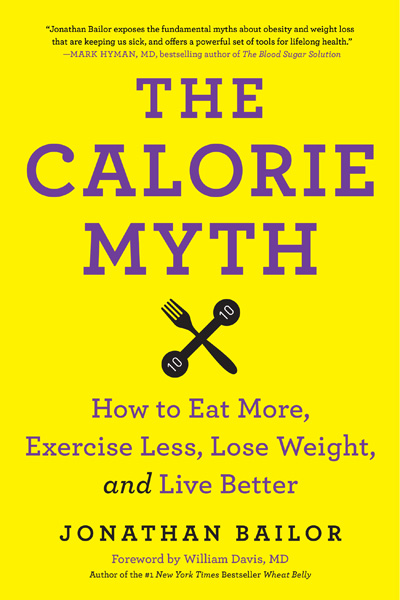The first person I saw that had this radical idea that everyone in America is sick because of what we eat was Dr Amen with his books about Brain health. People with similar views of the Western Diet followed. People like Mark Hyman (The Ultramind Solution) and JJ Virgin (The Virgin Diet) and Gary Taubes (Good Calories, Bad Calories) and one of my personal heroes Michael Pollan whose written a ton of great books including In Defense of Food and Cooked. Now I can add The Calorie Myth by Jonathan Bailor to the chorus of books touting the idea that we should eat real food.
 In the Calorie Myth Jonathan Bailor tells us that some calories are more equal than others. The problem is a simple one, the idea of calories is far too easy to understand. A calorie is a unit of measurement, like a gallon or a pound. So we have this odd idea that a calorie should be the same no matter where that calorie comes from. The easiest way to think about how wrong this is by using a gallon. A car runs fine on a gallon of gas, but not so great on a gallon of milk. They are both gallons, but they are not exactly the same.
In the Calorie Myth Jonathan Bailor tells us that some calories are more equal than others. The problem is a simple one, the idea of calories is far too easy to understand. A calorie is a unit of measurement, like a gallon or a pound. So we have this odd idea that a calorie should be the same no matter where that calorie comes from. The easiest way to think about how wrong this is by using a gallon. A car runs fine on a gallon of gas, but not so great on a gallon of milk. They are both gallons, but they are not exactly the same.
And yet, the idea that a calorie of spinach is good for you while a calorie of candy bar is not is one of those things that people are willing to go to war over.
A good deal of the problem goes back to the old Calories In Calories Out battle. Again, it is something that appears so obvious, so common sense, so absolutely true that no one can believe that it is total nonsense. Jonathan makes the case that if eating more calories than you burned made you fat, why aren’t all obese people 4,000 pounds instead of 400? If you add up all the calories eaten by people who sit around and watch TV all day, they should be a lot fatter than they are, if it was a simple math problem. But the human body isn’t simple. It’s a complex system that regulates itself.
As with other books of a similar nature, Jonathnan Bailor suggests a few things you can do to feel better. First off, stop eating just about everything you have eaten your entire life. Really, no sugars, no starches, and few fats. On the plus side you can have all the celery, spinach, and chia seeds you want.
To most Americans these diets are like being given a sports car and then being told you can drive it all you want during rush hour, but pull over and turn the engine off if you get on an open road. Somehow the idea of having ten servings a day of Nonstarchy Vegetables with Nutrient-Dense Proteins and Whole-Food Fats/Low-Fructose Fruits doesn’t sound all that appealing.
But I still like the idea. Like many other diet books, Jonathan recommends following his plan for Five Weeks and then once you see how great you feel, stick with it for the rest of your life. In all fairness The Calorie Myth has long lists of approved Carbs, Fats, and Protiens and he does say to eat a lot. He has a few recipes such as one for a smoothie made mostly of spinach and avocados with a bit of coconut milk. I tried adding some spinach to my morning protien shake it was not bad.
He also some interesting ideas about exercise, but I’m not as interested in exercise as I once was.
I liked The Calorie Myth: How to Eat More, Exercise Less, Lose Weight, and Live Bettereven if I may never follow all of it’s advice.
- Starfield – A Few Months In - December 23, 2023
- Still Just A Geek by Wil Wheaton - November 1, 2022
- Starfield First Impressions of Gameplay Reveal - June 13, 2022